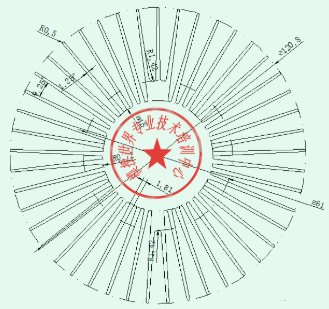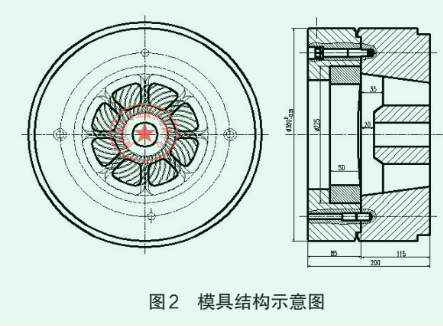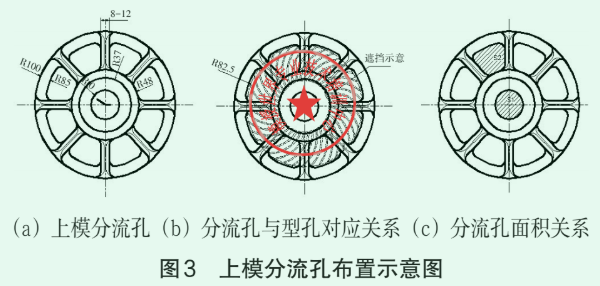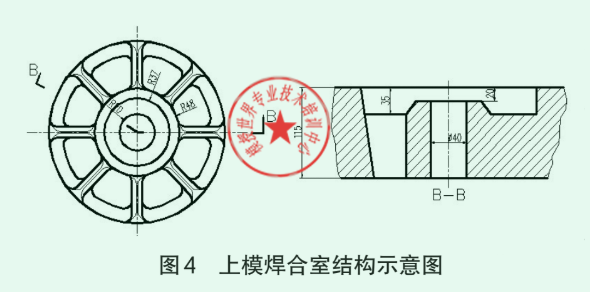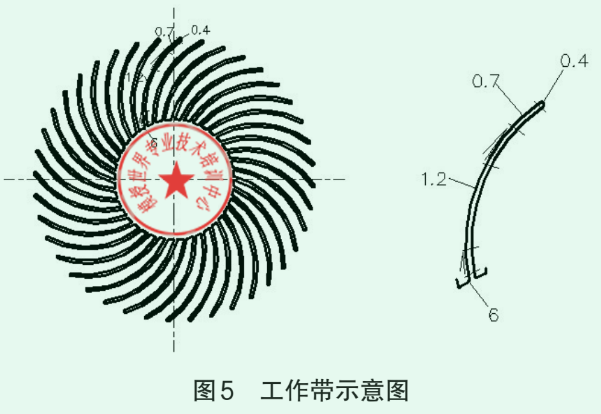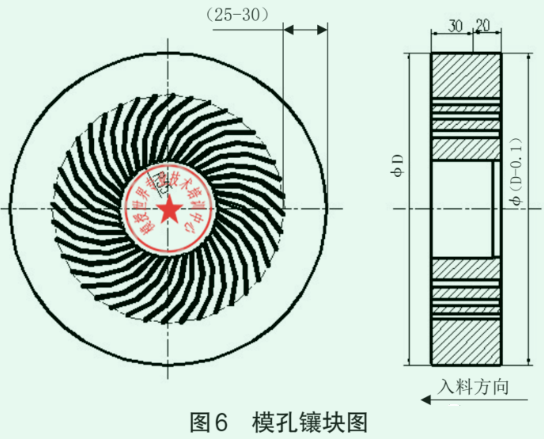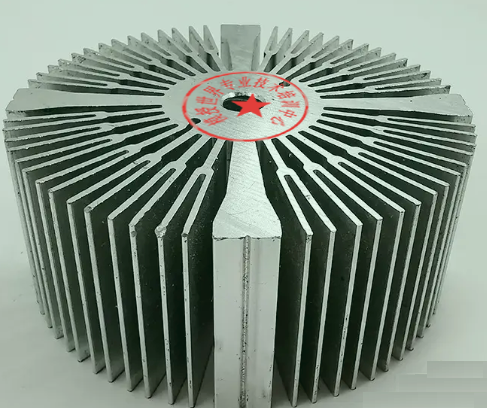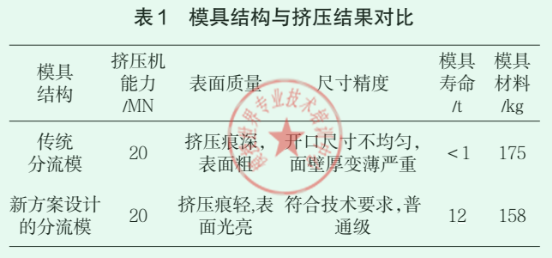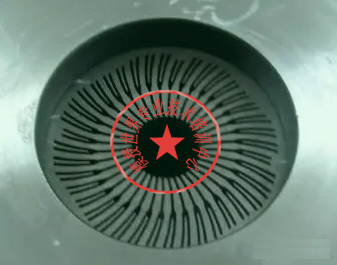Because aluminum alloys are lightweight, beautiful, have good corrosion resistance, and have excellent thermal conductivity and processing performance, they are widely used as heat dissipation components in the IT industry, electronics and automotive industries, especially in the currently emerging LED industry. These aluminum alloy heat dissipation components have good heat dissipation functions. In production, the key to efficient extrusion production of these radiator profiles is the mold. Because these profiles generally have the characteristics of large and dense heat dissipation teeth and long suspension tubes, the traditional flat die structure, split die structure and semi-hollow profile die structure cannot well meet the requirements of mold strength and extrusion molding.
At present, enterprises rely more on the quality of mold steel. In order to improve the strength of the mold, they do not hesitate to use expensive imported steel. The cost of the mold is very high, and the actual average life of the mold is less than 3t, resulting in the market price of the radiator being relatively high, seriously restricting the promotion and popularization of LED lamps. Therefore, extrusion dies for sunflower-shaped radiator profiles have attracted great attention from engineering and technical personnel in the industry.
This article introduces the various technologies of the sunflower radiator profile extrusion die obtained through years of painstaking research and repeated trial production through examples in actual production, for reference by peers.
1. Analysis of structural characteristics of aluminum profile sections
Figure 1 shows the cross-section of a typical sunflower radiator aluminum profile. The cross-sectional area of the profile is 7773.5mm², with a total of 40 heat dissipation teeth. The maximum hanging opening size formed between the teeth is 4.46 mm. After calculation, the tongue ratio between the teeth is 15.7. At the same time, there is a large solid area in the center of the profile, with an area of 3846.5mm².
Judging from the shape characteristics of the profile, the space between the teeth can be considered as semi-hollow profiles, and the radiator profile is composed of multiple semi-hollow profiles. Therefore, when designing the mold structure, the key is to consider how to ensure the strength of the mold. Although for semi-hollow profiles, the industry has developed a variety of mature mold structures, such as “covered splitter mold”, “cut splitter mold”, “suspension bridge splitter mold”, etc. However, these structures are not applicable to products composed of multiple semi-hollow profiles. Traditional design only considers materials, but in extrusion molding, the greatest impact on strength is the extrusion force during the extrusion process, and the metal forming process is the main factor generating extrusion force.
Due to the large central solid area of the solar radiator profile, it is very easy to cause the overall flow rate in this area to be too fast during the extrusion process, and the additional tensile stress will be generated on the head of the intertooth suspension tube, resulting in the fracture of the intertooth suspension tube. Therefore, in the design of the mold structure, we should focus on the adjustment of metal flow rate and flow rate to achieve the purpose of reducing extrusion pressure and improving the stress state of the suspended pipe between teeth, so as to improve the strength of the mold.
2. Selection of mold structure and extrusion press capacity
2.1 Mold structure form
For the sunflower radiator profile shown in Figure 1, although it does not have a hollow part, it must adopt the split mold structure as shown in Figure 2. Different from the traditional shunt mold structure, the metal soldering station chamber is placed in the upper mold, and an insert structure is used in the lower mold. The purpose is to reduce mold costs and shorten the mold manufacturing cycle. Both the upper mold and lower mold sets are universal and can be reused. More importantly, the die hole blocks can be processed independently, which can better ensure the accuracy of the die hole work belt. The inner hole of the lower mold is designed as a step. The upper part and the mold hole block adopt clearance fit, and the gap value on both sides is 0.06~0.1m; the lower part adopts interference fit, and the interference amount on both sides is 0.02~0.04m, which helps ensure coaxiality and facilitates assembly, making the inlay fit more compact, and at the same time, it can avoid mold deformation caused by thermal installation interference fit.
2.2 Selection of extruder capacity
The selection of the extruder capacity is, on the one hand, to determine the appropriate inner diameter of the extrusion barrel and the maximum specific pressure of the extruder on the extrusion barrel section to meet the pressure during metal forming. On the other hand, it is to determine the appropriate extrusion ratio and select the appropriate mold size specifications based on cost. For the sunflower radiator aluminum profile, the extrusion ratio cannot be too large. The main reason is that the extrusion force is proportional to the extrusion ratio. The greater the extrusion ratio, the greater the extrusion force. This is extremely detrimental to the sunflower radiator aluminum profile mold.
Experience shows that the extrusion ratio of aluminum profiles for sunflower radiators is less than 25. For the profile shown in Figure 1, a 20.0 MN extruder with an extrusion barrel inner diameter of 208 mm was selected. After calculation, the maximum specific pressure of the extruder is 589MPa, which is a more appropriate value. If the specific pressure is too high, the pressure on the mold will be large, which is detrimental to the life of the mold; if the specific pressure is too low, it cannot meet the requirements of extrusion forming. Experience shows that a specific pressure in the range of 550~750 MPa can better meet various process requirements. After calculation, the extrusion coefficient is 4.37. The mold size specification is selected as 350 mmx200 mm (outer diameter x degrees).
3. Determination of mold structural parameters
3.1 Upper mold structural parameters
(1) Number and arrangement of diverter holes. For the sunflower radiator profile shunt mold, the more the number of shunt holes, the better. For profiles with similar circular shapes, 3 to 4 traditional shunt holes are generally selected. The result is that the width of the shunt bridge is larger. Generally, when it is larger than 20mm, the number of welds is less. However, when selecting the working belt of the die hole, the working belt of the die hole at the bottom of the shunt bridge must be shorter. Under the condition that there is no precise calculation method for the selection of the working belt, it will naturally cause the die hole under the bridge and other parts to not achieve exactly the same flow rate during extrusion due to the difference in the working belt, This difference in flow rate will produce additional tensile stress on the cantilever and cause deflection of the heat dissipation teeth. Therefore, for the sunflower radiator extrusion die with a dense number of teeth, it is very critical to ensure that the flow rate of each tooth is consistent. As the number of shunt holes increases, the number of shunt bridges will increase accordingly, and the flow rate and flow distribution of the metal will become more even. This is because as the number of shunt bridges increases, the width of the shunt bridges can be reduced accordingly.
Practical data shows that the number of shunt holes is generally 6 or 8, or even more. Of course, for some large sunflower heat dissipation profiles, the upper mold can also arrange the shunt holes according to the principle of the shunt bridge width ≤ 14mm. The difference is that a front splitter plate must be added to pre-distribute and adjust the metal flow. The number and arrangement of the diverter holes in the front diverter plate can be carried out in a traditional way.
In addition, when arranging the shunt holes, consideration should be given to using the upper mold to appropriately shield the head of the cantilever of the heat dissipation tooth to prevent the metal from directly hitting the head of the cantilever tube and thus improve the stress state of the cantilever tube. The blocked part of the cantilever head between the teeth can be 1/5~1/4 of the length of the cantilever tube. The layout of the shunt holes is shown in Figure 3
(2) The area relationship of the shunt hole. Because the wall thickness of the root of the hot tooth is small and the height is far from the center, and the physical area is very different from the center, it is the most difficult part to form metal. Therefore, a key point in the design of the sunflower radiator profile mold is to make the flow rate of the central solid part as slow as possible to ensure that the metal first fills the root of the tooth. In order to achieve such an effect, on the one hand, it is the selection of the working belt, and more importantly, the determination of the area of the diverter hole, mainly the area of the central part corresponding to the diverter hole. Tests and empirical values show that the best effect is achieved when the area of the central diverter hole S1 and the area of the external single diverter hole S2 satisfy the following relationship: S1= (0.52 ~0.72) S2
In addition, the effective metal flow channel of the central splitter hole should be 20~25mm longer than the effective metal flow channel of the outer splitter hole. This length also takes into account the margin and possibility of mold repair.
(3) Depth of the welding chamber. The Sunflower radiator profile extrusion die is different from the traditional shunt die. Its entire welding chamber must be located in the upper die. This is to ensure the accuracy of the hole block processing of the lower die, especially the accuracy of the working belt. Compared with the traditional shunt mold, the depth of the welding chamber of the Sunflower radiator profile shunt mold needs to be increased. The greater the extrusion machine capacity, the greater the increase in the depth of the welding chamber, which is 15~25mm. For example, if a 20 MN extrusion machine is used, the depth of the welding chamber of the traditional shunt die is 20~22mm, while the depth of the welding chamber of the shunt die of the sunflower radiator profile should be 35~40 mm. The advantage of this is that the metal is fully welded and the stress on the suspended pipe is greatly reduced. The structure of the upper mold welding chamber is shown in Figure 4.
3.2 Design of die hole insert
The design of the die hole block mainly includes the die hole size, working belt, outer diameter and thickness of the mirror block, etc.
(1) Determination of die hole size. The die hole size can be determined in a traditional way, mainly considering the scaling of alloy thermal processing.
(2) Selection of work belt. The principle of working belt selection is to first ensure that the supply of all metal at the bottom of the tooth root is sufficient, so that the flow rate at the bottom of the tooth root is faster than other parts. Therefore, the working belt at the bottom of the tooth root should be the shortest, with a value of 0.3~0.6mm, and the working belt at the adjacent parts should be increased by 0.3mm. The principle is to increase by 0.4~0.5 every 10~15mm toward the center; secondly, the working belt at the largest solid part of the center should not exceed 7mm. Otherwise, if the length difference of the working belt is too large, large errors will occur in the processing of copper electrodes and EDM processing of the working belt. This error can easily cause the tooth deflection to break during the extrusion process. The work belt is shown in Figure 5.
(3) The outer diameter and thickness of the insert. For traditional shunt molds, the thickness of the die hole insert is the thickness of the lower mold. However, for the sunflower radiator mold, if the effective thickness of the die hole is too large, the profile will easily collide with the mold during extrusion and discharging, resulting in uneven teeth, scratches or even tooth jamming. These will cause the teeth to break.
In addition, if the thickness of the die hole is too long, on the one hand, the processing time is long during the EDM process, and on the other hand, it is easy to cause electrical corrosion deviation, and it is also easy to cause tooth deviation during extrusion. Of course, if the die hole thickness is too small, the strength of the teeth cannot be guaranteed. Therefore, taking these two factors into consideration, experience shows that the die hole insert degree of the lower mold is generally 40 to 50; and the outer diameter of the die hole insert should be 25 to 30 mm from the largest edge of the die hole to the outer circle of the insert.
For the profile shown in Figure 1, the outer diameter and thickness of the die hole block are 225mm and 50mm respectively. The die hole insert is shown in Figure 6. D in the figure is the actual size and the nominal size is 225mm. The limit deviation of its outer dimensions is matched according to the inner hole of the lower mold to ensure that the unilateral gap is within the range of 0.01~0.02mm. The die hole block is shown in Figure 6. The nominal size of the inner hole of the die hole block placed on the lower mold is 225mm. Based on the actual measured size, the die hole block is matched according to the principle of 0.01~0.02mm per side. The outer diameter of the die hole block can be obtained as D , but for the convenience of installation, the outer diameter of the die hole mirror block can be appropriately reduced within the range of 0.1m at the feed end, as shown in the figure.
4. Key technologies of mold manufacturing
The machining of the Sunflower radiator profile mold is not much different from that of ordinary aluminum profile molds. The obvious difference is mainly reflected in the electrical processing.
(1) In terms of wire cutting, it is necessary to prevent the deformation of the copper electrode. Because the copper electrode used for EDM is heavy, the teeth are too small, the electrode itself is soft, has poor rigidity, and the local high temperature generated by wire cutting causes the electrode to be easily deformed during the wire cutting process. When using deformed copper electrodes to process work belts and empty knives, skewed teeth will occur, which can easily cause the mold to be scrapped during the processing. Therefore, it is necessary to prevent the deformation of the copper electrodes during the online manufacturing process. The main preventive measures are: before wire cutting, level the copper block with a bed; use a dial indicator to adjust the verticality at the beginning; when wire cutting, start from the tooth part first, and finally cut the part with thick wall; Every once in a while, use scrap silver wire to fill the cut parts; after the wire is made, use a wire machine to cut off a short section of about 4 mm along the length of the cut copper electrode.
(2) Electrical discharge machining is obviously different from ordinary molds. EDM is very important in the processing of sunflower radiator profile molds. Even if the design is perfect, a slight defect in EDM will cause the entire mold to be scrapped. Electric discharge machining is not as dependent on equipment as wire cutting. It depends largely on the operator’s operating skills and proficiency. Electric discharge machining mainly pays attention to the following five points:
①Electrical discharge machining current. 7~10 A current can be used for initial EDM machining to shorten the processing time; 5~7 A current can be used for finishing machining. The purpose of using small current is to obtain a good surface;
② Ensure the flatness of the mold end face and the verticality of the copper electrode. Poor flatness of the mold end face or insufficient verticality of the copper electrode makes it difficult to ensure that the length of the work belt after EDM processing is consistent with the designed work belt length. It is easy for the EDM process to fail or even penetrate the toothed work belt. Therefore, before processing, a grinder must be used to flatten both ends of the mold to meet the accuracy requirements, and a dial indicator must be used to correct the verticality of the copper electrode;
③ Ensure that the gap between the empty knives is even. During initial machining, check whether the empty tool is offset every 0.2 mm every 3 to 4 mm of processing. If the offset is large, it will be difficult to correct it with subsequent adjustments;
④Remove the residue generated during the EDM process in a timely manner. Spark discharge corrosion will produce a large amount of residue, which must be cleaned up in time, otherwise the length of the working belt will be different due to the different heights of the residue;
⑤The mold must be demagnetized before EDM.
5. Comparison of extrusion results
The profile shown in Figure 1 was tested using the traditional split mold and the new design scheme proposed in this article. The comparison of the results is shown in Table 1.
It can be seen from the comparison results that the mold structure has a great influence on the mold life. The mold designed using the new scheme has obvious advantages and greatly improves the mold life.
6. Conclusion
The sunflower radiator profile extrusion mold is a type of mold that is very difficult to design and manufacture, and its design and manufacturing are relatively complex. Therefore, to ensure the extrusion success rate and service life of the mold, the following points must be achieved:
(1) The structural form of the mold must be selected reasonably. The structure of the mold must be conducive to reducing the extrusion force to reduce the stress on the mold cantilever formed by the heat dissipation teeth, thereby improving the strength of the mold. The key is to reasonably determine the number and arrangement of the shunt holes and the area of the shunt holes and other parameters: first, the width of the shunt bridge formed between the shunt holes should not exceed 16mm; Second, the split hole area should be determined so that the split ratio reaches more than 30% of the extrusion ratio as much as possible while ensuring the strength of the mold.
(2) Reasonably select the work belt and adopt reasonable measures during electrical machining, including the processing technology of copper electrodes and the electrical standard parameters of electrical machining. The first key point is that the copper electrode should be surface ground before wire cutting, and the insertion method should be used during wire cutting to ensure it. The electrodes are not loose or deformed.
(3) During the electrical machining process, the electrode must be accurately aligned to avoid tooth deviation. Of course, on the basis of reasonable design and manufacturing, the use of high-quality hot-work mold steel and the vacuum heat treatment process of three or more tempers can maximize the potential of the mold and achieve better results. From design, manufacturing to extrusion production, only if each link is accurate can we ensure that the sunflower radiator profile mold is extruded.
Post time: Aug-01-2024



